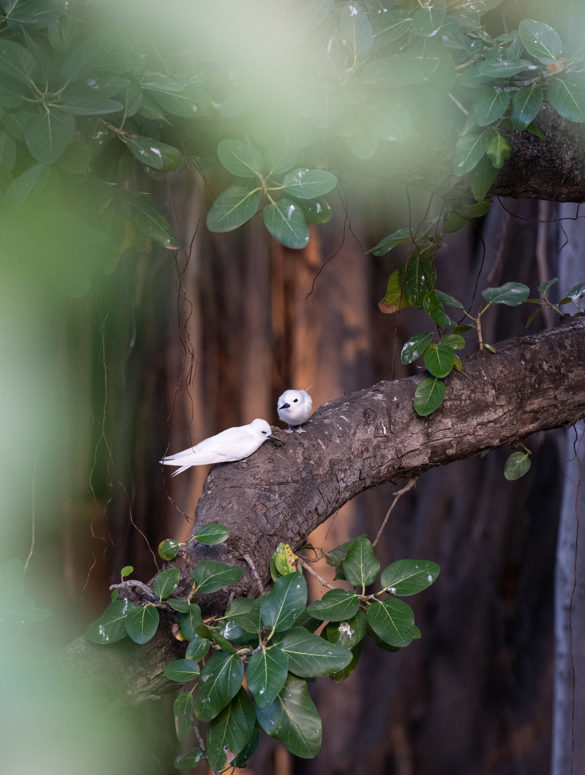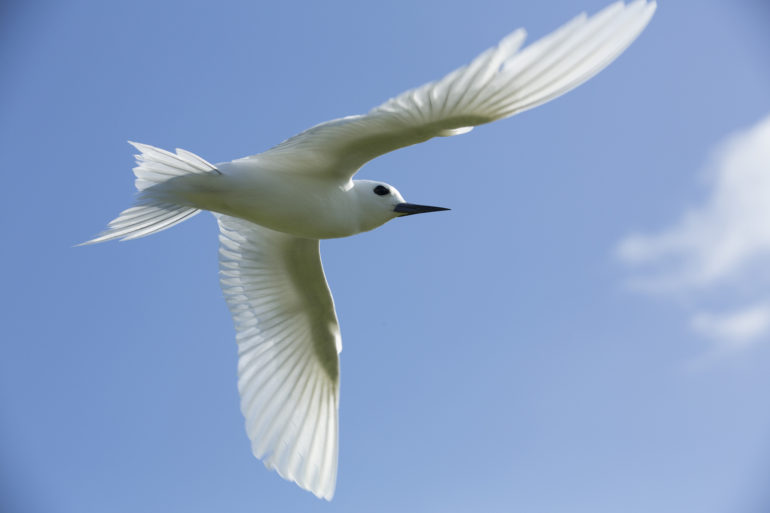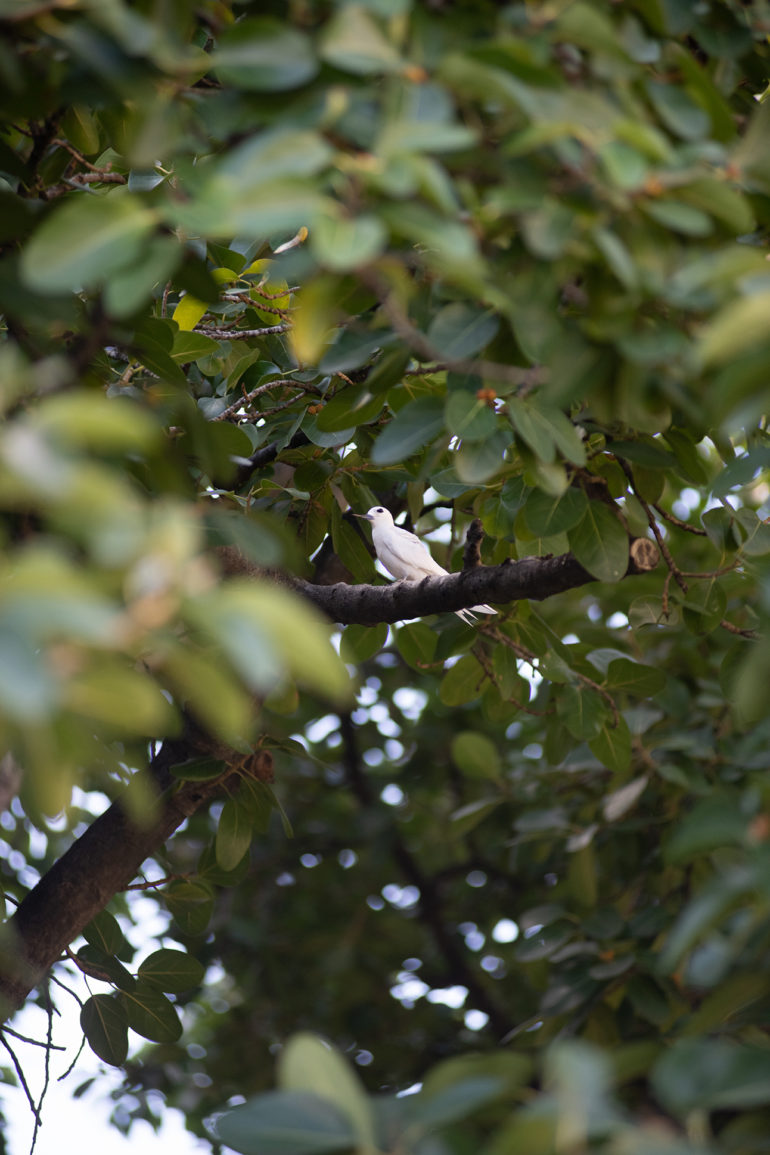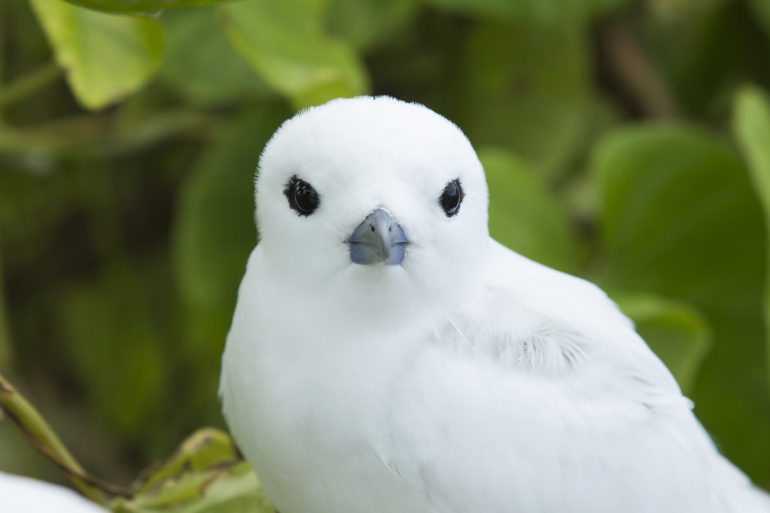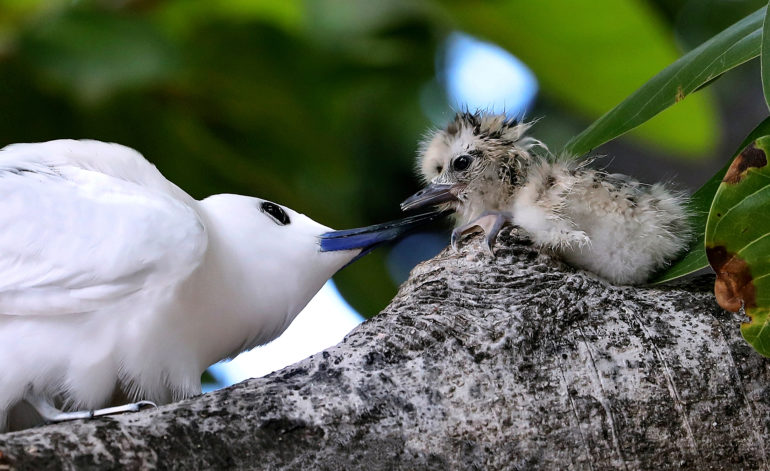I noticed the blue bands before I saw the birds. Along Kalākaua Avenue, between Kapi‘olani Boulevard and King Street, where the road is split by a line of giant mahogany trees, about every third trunk was bisected by a bright blue ribbon. From my car, I couldn’t make out what was written on them, so later I returned on foot to read the tape on the nearest tree: “NESTING WHITE TERNS • TRIM WITH CAUTION.”
The white tern (Gygis alba), known in Hawaiian as manu o Kū (the bird of Kū), is a smallish white seabird that is native to Hawai‘i and common throughout the tropics. It’s sometimes called the white fairy tern, and it is easy to see why: by flapping its wings in rapid succession, the white tern can hover in place, much like a hummingbird or dragonfly.
Unlike many of Hawai‘i’s native bird species, which have succumbed to alien predators and the decimation of their habitats, the manu o Kū is thriving. And not in the far reaches of the archipelago, but in some of the busiest, most congested neighborhoods in Honolulu. Walk around Mō‘ili‘ili or Waikīkī and chances are you’ll spy a tree marked with the blue ribbon, known affectionately to local conservationists as “tern tape.”
Honolulu is home to more than 2,300 manu o Kū, including roughly 700 breeding pairs whose nesting sites are plotted online on a citizen-run, active-nest map. In 2007, Gygis alba was named the official bird of Honolulu, thanks to the lobbying of local scientists and civic leaders like Laura Thompson, wife of former mayor Myron “Pinky” Thompson and mother of voyager Nainoa Thompson.
Manu o Kū is an especially useful bird to seafarers, thanks to its habit of fishing at sea during the day—plucking juvenile fish and squid from the water without getting wet—and then beelining back to land at sunset. Navigators watch for white terns with beaks full of small fish and use the bird’s flight direction to orient their canoes.
In 2016, a group of scientists and amateur ornithologists organized as the Hui Manu o Kū, deploying the blue tape to communicate to tree trimmers where the birds are nested and debuting the first Manu o Kū Festival at ‘Iolani Palace to raise awareness of the bird’s cultural and biological significance. Keiki made fluffy manu o Kū chicks out of cotton balls and tossed plastic squids into the mouth of an oversized seabird.
Scientists have little reliable information on how many manu o Kū were supported on O‘ahu prior to 1778, but they do know that for much of the past two centuries, white terns were far less common than they are today, in part due to a demand for feathers in the 19th century.
In 1918, the white tern became one of hundreds of bird species protected by the Migratory Bird Treaty Act, one of the oldest wildlife protection laws in the United States. In 1961, a pair of white terns was spotted in a kiawe tree near Hanauma Bay. It was the first documented case of manu o Kū breeding in Honolulu. Since then, the population has steadily grown, leaving ornithologists wondering, why Honolulu? And why now?
It turns out that humans and white terns like a lot of the same things. The broad-canopied trees Honolulu city planners imported from places like Mexico and India provide shade but also large limbs on which to lay eggs. (White terns do not build nests but rather lay eggs directly onto tree branches or even manmade structures like windowsills.)
In an urban environment, trees are trimmed to ensure public safety, and that too benefits the manu o Kū, says Rich Downs, who helped found Hui Manu o Kū. When a limb is removed from a tree, it leaves a wound that scars over, creating grooves and divots that are, it turns out, perfect for egg-laying. “If you take two trees, same species, and one is trimmed and the other one is not trimmed, they will invariably use the one that’s been trimmed,” Downs says.
Similarly, contemporary urban life tends to ward off predators. Along Kalākaua Avenue, the heavily trafficked street acts as a protective moat that cats and mongooses have a hard time crossing. White terns generally seem not to mind the constant noise and artificial illumination of the city, which further insulates them from rats and other predators.
In a time when the impact of humans on the environment is plainer than ever, it can be startling to realize that not all our actions are detrimental to the world around us; to realize that, every so often, we stumble into creating new habitats in the middle of our cities, along our streets and in our literal back yards. In the case of manu o Kū, this inadvertent caretaking has led to intentional interventions: knocking dimples in concrete ledges and affixing pieces of scrap wood to branches to create more secure brooding spots, small gestures that feel huge against the backdrop of ecosystem collapse.
Not long ago, I returned to that bustling stretch of Kalākaua Avenue. Almost immediately, I caught sight of a manu o Kū, high on a branch, its slender, white body bright against the dark green leaves, its beak pointed and tinged with blue, like the tip of a brush wet with paint. I saw another, then another, until the sky seemed full of them. They fluttered from branch to branch in groups of four or five, occasionally wheeling up over the street, like kids playing tag. Their bodies were smaller than their full-grown size, and I wondered if they were adolescents, fledglings trying out their wings.
It can be dangerous to ascribe human traits to animals, masking their true characteristics and leaving us blind to biological relationships that defy our logic. But occasionally, we observe behavior in another species that feels so familiar it’s difficult not to see ourselves in them.
As the terns chased each other through the trees, I found myself longing to be one of them, not to experience the feeling of flight, but to again safely be part of a group, to feel that sense of togetherness. I envied their freedom. These birds knew nothing of the coronavirus plaguing the human race, though certainly they noticed our retreat from public spaces. Watching them interact, my terrestrial confinement felt all the more pronounced.
The presence of the manu o Kū in Honolulu is often framed as a heartwarming story of cohabitation. But just because humanity’s current approach to building cities works for the white tern does not mean we should ignore its more destructive aspects—the hundreds of species that cannot live in our street trees, that are driven away or poisoned by our traffic, that are disoriented by our city’s lights.
The lesson of the manu o Kū is not to carry on and assume the world will adapt, but rather to observe up close, within the hubbub of our daily lives, the ways in which our actions ripple outward, affecting innumerable species in innumerable ways. The bird is not a sanction on our way of life. It’s an invitation to pay attention.

